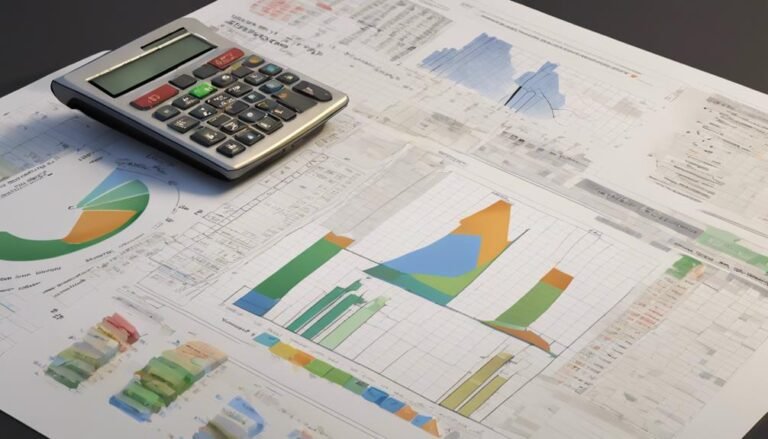Asset Valuation Techniques in Financial Accounting
When valuing assets in financial accounting, you can employ methods like Historical Cost, Market Value, Income Approach, and more. Historical Cost captures original purchase prices for consistency. Market Value gauges asset worth by analyzing fair market value. Income Approach focuses on income-generating potential using methods like Discounted Cash Flows. Replacement Cost reveals current values based on replacement expenses. Discounted Cash Flow Analysis emphasizes the Time Value of Money for future cash flow evaluations. These techniques help in accurate valuation and strategic decision-making. Discover varied asset valuation approaches for in-depth financial insights.
Key Takeaways
- Historical Cost Method records assets at original purchase price for consistency.
- Market Value Approach determines asset worth based on fair market value for risk assessment.
- Income Approach focuses on Discounted Cash Flows to assess present value.
- Replacement Cost Technique determines current asset value based on replacement cost.
- Discounted Cash Flow Analysis evaluates future cash flows for accurate valuation.
Historical Cost Method
When utilizing the Historical Cost Method in financial accounting, companies record assets at their original purchase price. This method is one of the traditional costing methods used for inventory valuation. It involves valuing assets based on the actual amount paid for them at the time of acquisition. The Historical Cost Method is relatively simple and easy to apply compared to other asset valuation techniques.
One of the key advantages of the Historical Cost Method is its consistency in financial reporting. By recording assets at their historical cost, companies can avoid fluctuations in reported values that may arise with other methods like asset revaluation. This stability in financial statements provides a clear and reliable picture of the company's financial position over time. Additionally, the Historical Cost Method is less subjective compared to methods involving asset revaluation, making it a preferred choice for many businesses, especially when dealing with tangible assets like property, plant, and equipment.
Market Value Approach
In financial accounting, the Market Value Approach is a valuation technique that determines the worth of assets based on their current fair market value. This approach involves analyzing the market prices of similar assets through comparative analysis to ascertain an asset's value accurately. By considering the prices at which comparable assets are being bought or sold, companies can make more informed decisions regarding the valuation of their own assets.
Moreover, the Market Value Approach aids in risk assessment by providing real-time insights into the potential risks associated with the current value of assets. Understanding the market value of assets helps in evaluating the potential losses a company might face if the assets were to be sold or liquidated in the current market conditions. This information is essential for companies to assess their financial health accurately and make strategic decisions to mitigate risks and optimize their asset portfolio.
Income Approach
When considering asset valuation through the Income Approach, you'll focus on methodologies such as:
- Discounted Cash Flows
- Capitalization of Earnings
- Price-To-Earnings Ratio
These techniques assess the present value of expected future cash flows or earnings generated by the asset. By utilizing these methods, you can determine the value of the asset based on its income-generating potential.
Discounted Cash Flows
Utilizing discounted cash flows as an income approach in asset valuation involves evaluating the expected future cash inflows and outflows to determine the present value of an asset. By discounting these cash flows back to their present value using an appropriate discount rate, analysts can assess the attractiveness of an investment or the value of a business. When estimating cash flows, it is important to take into account factors that could impact their accuracy, such as market conditions, competition, and regulatory changes. Conducting sensitivity analysis on key variables can help evaluate the impact of different scenarios on the valuation outcome, enhancing the comprehensive of the analysis.
| Advantages | Disadvantages |
|---|---|
| Accounts for time value of money | Requires accurate cash flow projections |
| Considers risk through discount rate | Sensitivity to changes in discount rate |
| Provides a detailed view of value | Relies on future estimations |
| Incorporates growth potential | Complex calculations |
| Useful for long-term investments | Can be subjective in determining inputs |
Capitalization of Earnings
To apply the capitalization of earnings approach effectively for asset valuation, it's essential to ascertain the sustainable earnings of the asset and determine a suitable capitalization rate based on the perceived risk and return profile. The capitalization method under this approach involves adjusting earnings to reflect the true economic benefit derived from the asset.
Here's how you can effectively utilize the capitalization of earnings method:
- Identify Sustainable Earnings: Analyze historical financial data to determine the average earnings generated by the asset over a period, ensuring they represent a sustainable level of income.
- Earnings Adjustment: Make necessary adjustments to the earnings figure to eliminate one-time gains or losses, non-recurring expenses, or any anomalies that may distort the true earnings potential of the asset.
- Determine Capitalization Rate: Evaluate the risk associated with the asset and establish a suitable capitalization rate that reflects the required rate of return for investors based on the asset's risk profile and market conditions.
Price-To-Earnings Ratio
To gain further insights into asset valuation within financial accounting, exploring the Price-To-Earnings Ratio (Income Approach) offers a valuable perspective on evaluating the asset's market performance and investor sentiment. The Price-To-Earnings Ratio (P/E ratio) is calculated by dividing the market price per share by the earnings per share. It is a widely used metric to assess how the market values a company's earnings.
When analyzing the P/E ratio, two key factors to take into account are earnings growth and peer comparison. Earnings growth is essential as it indicates the company's potential to generate higher profits in the future, which can impact the P/E ratio. Peer comparison helps in understanding whether the asset is overvalued or undervalued compared to similar companies in the industry.
Below is a table illustrating how the P/E ratio can vary based on different scenarios:
| Scenario | P/E Ratio |
|---|---|
| High Earnings Growth | Higher |
| Low Earnings Growth | Lower |
| Below Industry Average | Undervalued |
| Above Industry Average | Overvalued |
| Peer Comparison | Relative Value |
Replacement Cost Technique
In financial accounting, the Replacement Cost Technique provides a method for determining the current value of assets based on the cost to replace them at present market prices. This technique is particularly useful when considering the value of assets that have greatly fluctuated in price due to market trends.
Here are three key points to help you understand the Replacement Cost Technique:
- Cost Estimation: The Replacement Cost Technique requires a detailed analysis of the current market prices of assets to estimate the cost of replacing them. This involves considering factors such as inflation, technological advancements, and supply chain disruptions that may impact replacement costs.
- Market Trends: Understanding market trends is vital in the Replacement Cost Technique as it directly influences the cost of replacing assets. Keeping abreast of market fluctuations, demand-supply dynamics, and industry trends is essential for accurate asset valuation using this technique.
- Accuracy and Reliability: While the Replacement Cost Technique provides a current and relevant valuation of assets, it's important to confirm the accuracy of cost estimations and the reliability of market trend analysis to avoid overestimating or underestimating asset values.
Discounted Cash Flow Analysis
When considering Discounted Cash Flow Analysis, you must understand the concept of the Time Value of Money, which emphasizes that a dollar today is worth more than a dollar in the future.
You need to carefully evaluate the Future Cash Flows of the asset being analyzed to accurately predict its value.
Estimating the appropriate Discount Rate is pivotal for determining the present value of future cash flows and ensuring a reliable valuation.
Time Value of Money
Exploring the concept of the time value of money reveals the fundamental principle underlying discounted cash flow analysis. Understanding the relationship between the present value of money and interest rates is essential in financial accounting.
Here are three key points to help grasp the significance of the time value of money in discounted cash flow analysis:
- Present Value Importance: Recognizing that a dollar today is worth more than a dollar in the future due to the ability to invest it and earn returns is central to present value calculations.
- Interest Rates Impact: Changes in interest rates directly influence the present value of future cash flows, as higher rates reduce present value and vice versa.
- Discounted Cash Flow Analysis: By discounting future cash flows back to their present value using an appropriate discount rate, companies can assess the worth of an investment or asset today accurately.
Mastering the time value of money allows financial professionals to make informed decisions regarding investments, valuations, and financial planning.
Future Cash Flows
To effectively analyze future cash flows in financial accounting, you must employ discounted cash flow analysis to determine the present value of expected returns. This method involves forecasting future cash inflows and outflows, discounting them back to their present value using an appropriate discount rate. By incorporating sensitivity analysis, you can assess how changes in key variables impact the cash flow projections, allowing for a more vital evaluation of the asset's value under different scenarios.
Risk assessment is vital in evaluating future cash flows as it helps identify and mitigate potential risks that could affect the accuracy of cash flow projections. Scenario planning enables you to develop multiple future scenarios based on different assumptions, providing a more inclusive view of potential outcomes. Uncertainty modeling allows for the incorporation of various levels of uncertainty into the cash flow projections, helping to account for the unpredictable nature of future events. By utilizing these techniques, you can enhance the accuracy and reliability of your asset valuation in financial accounting.
Discount Rate Estimation
Estimating the discount rate in discounted cash flow analysis is a critical step in determining the present value of future cash flows. The discount rate reflects the time value of money and the associated risks. Here are key points to ponder when estimating the discount rate:
- Estimation Accuracy: The accuracy of the discount rate directly impacts the valuation of the asset. Small variations in the discount rate can lead to significant differences in the calculated present value. It's vital to use appropriate methods and data to estimate the discount rate accurately.
- Sensitivity Analysis: Conducting sensitivity analysis on the discount rate helps assess the impact of different discount rate scenarios on the asset's valuation. By analyzing how changes in the discount rate affect the present value, you can better grasp the risks and uncertainties associated with the valuation.
- Risk Premium Consideration: When estimating the discount rate, it's important to incorporate a risk premium that reflects the specific risks associated with the asset or investment. This ensures that the discount rate adequately captures all relevant factors affecting the asset's value.
Net Realizable Value Method
The Net Realizable Value Method is an essential technique in financial accounting for determining the estimated selling price of an asset minus the costs of completing the sale. This method is particularly vital for inventory valuation and accounts receivable adjustments.
When applying this method to inventory, companies assess the net realizable value by considering the estimated selling price of the goods minus any additional costs necessary to get them ready for sale. If the net realizable value falls below the carrying amount of the inventory, adjustments such as inventory write-offs may be required to reflect the lower value accurately.
Similarly, for accounts receivable, the net realizable value is determined by subtracting any estimated allowances for doubtful accounts from the total accounts receivable balance. This adjustment ensures that the accounts receivable balance on the financial statements accurately reflects the amount expected to be collected, thereby aiding in presenting a true and fair view of the company's financial position.
Fair Value Measurement
When evaluating asset valuation, Fair Value Measurement offers an important framework for determining the market value of assets in financial accounting practices. Fair value assessment involves the use of specific valuation techniques to ascertain the worth of assets accurately.
- Market-Based Approach: Fair value measurement relies on market prices or observable market data to determine the value of assets. This approach provides a transparent and reliable way to assess asset values.
- Income Approach: Another valuation technique used in fair value assessment is the income approach, which calculates an asset's value based on its expected future cash flows. This method is particularly useful for assets without active markets.
- Cost Approach: The cost approach under fair value measurement involves determining the value of an asset by considering the cost to replace it with a similar asset. This technique provides a practical way to assess the value of assets with limited market data available.
Depreciated Replacement Cost Model
Utilizing the Depreciated Replacement Cost Model in asset valuation involves determining the current value of an asset by considering its original cost and the accumulated depreciation over time. Cost estimation under this model requires a detailed analysis of the asset's historical cost, any subsequent improvements, and the depreciation incurred. By factoring in the depreciation accumulated over the asset's useful life, you can arrive at a more accurate valuation that reflects the current condition and worth of the asset.
Asset valuation using the Depreciated Replacement Cost Model offers a practical approach for businesses to assess the value of their assets. It provides a more realistic representation of an asset's worth compared to methods solely based on historical costs. This model enables businesses to make informed decisions regarding asset management, replacement, or potential sale based on up-to-date valuations. Incorporating the Depreciated Replacement Cost Model into asset valuation practices can enhance financial reporting accuracy and facilitate better strategic planning.
Liquidation Value Assessment
Evaluating the liquidation value of assets offers an important insight into their worth in scenarios of potential sale or dissolution. In forced liquidation scenarios or during bankruptcy proceedings, understanding the liquidation value becomes essential for stakeholders.
Here are three key points to keep in mind when examining liquidation value:
- Forced Liquidation Scenarios: In situations where assets need to be sold quickly, often at a discount, due to financial distress or insolvency, the liquidation value provides a realistic estimate of the cash that could be generated.
- Bankruptcy Implications: The liquidation value plays a significant role in bankruptcy proceedings, helping to determine the order in which creditors are paid. Understanding the liquidation value is necessary for evaluating potential recovery in such situations.
- Asset Valuation Challenges: Evaluating the liquidation value can be challenging, especially when dealing with intangible assets like goodwill or intellectual property. These assets may not have a readily determinable market value, making their liquidation value estimation more complex.
Residual Value Estimation
Evaluating the residual value of assets after their useful life is an essential aspect of financial accounting and investment decision-making. Residual value forecasting involves estimating the monetary value an asset will hold at the end of its useful life or lease period. This estimation is critical for determining depreciation, investment returns, and potential resale value. However, residual value forecasting comes with inherent risks that need to be carefully considered. Factors such as market fluctuations, technological advancements, and unexpected events can greatly impact the actual residual value of an asset, leading to potential financial losses for companies and investors.
To better understand residual value forecasting and the associated risks, consider the following table:
| Factors Influencing Residual Value | Risks |
|---|---|
| Market Demand | Market Fluctuations |
| Asset Condition | Technological Obsolescence |
| Economic Trends | Unexpected Events |
| Maintenance Costs | Competition |
Conclusion
Finally, you have now mastered the art of asset valuation techniques in financial accounting. Your analytical skills have been sharpened, your precision has been honed, and your attention to detail is impeccable.
You're now equipped with the tools necessary to navigate the complex world of asset valuation with ease and finesse. Congratulations, you're now a true connoisseur of financial accounting.








